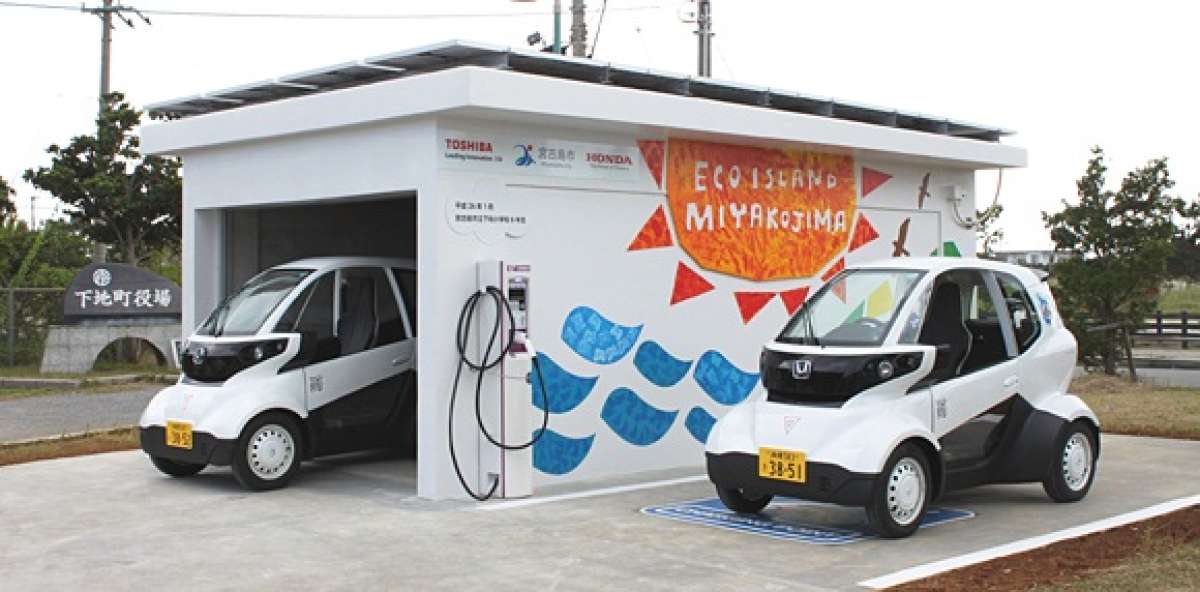Specifically designed for a ‘pending’ micro-car auto classification in Europe and Japan, Honda, a company of many firsts released the ‘concept’ MC-Beta in 2013 for testing in Japan.
As part of Honda’s “A Greener World” philosophy, three Cities in Japan and Toshiba corporation has joined the largest motor manufacturer in the world; in its ongoing study of future personal transportation modes, and how these micro vehicles may fit into the cities of the future.
While the mission statement has grand implications, the MC-Beta or MC-8 as covered by Torque News is very small. To comply with Europe and Japan’s pending micro-car classification the vehicle may weigh no more than 400 KG ( 880 lb) * excluding battery weight and produce no more than 15 kw, or 20 h.p..
Several inches shorter and narrower than an EV Smart Car, the MC-8 can be remotely parked with an app from your smartphone.
Developed utilizing Honda Motor Sports technology, the frame is tube and body, plastic composite. The manufacture claims that this staggered seating, two place personal transport will carry two adults in relative comfort while achieving ample if not a bit ‘lack-luster’ performance.
This low output (10 kw) motor will achieve a top speed of 70 kph (43 mph) and clock 0-50 kph in 10 seconds. The good news is that the MC-8 has an average stated range of 80 km between charges. Of course as with all EVs mileage will vary with weather, average speed and driving terrain. The narrow width to height ratio of the micro adds to body roll tendency and short-channeled ( wheelbase) chop associated with all micro-cars.
However those that have driven this smallest of EVs find it to be a viable, fun mode of intercity and neighborhood transportation. That’s what Honda designed the car to do.
The Japan MC-8 is equipped with a 100 and 200 amp dual mode charger and can be charged in 6 or 3 hours respectively on standard house current.
For our Electric Car fans, while the MC-8 has been deemed” too small” for America by the automotive press, we find that assessment to be a bit too broad.
License it, and they will buy it.
We believe that the future is bright for a high tech, next generation( small) battery cell powered people mover. Back in the late 1990s this writer took a ride in an electric Corbin Sparrow down in Hollister California. The Sparrow was a very viable, mold injected mono frame 1 place 3 wheeled electric car; licensed in California as a motorcycle.
With unlimited torque and CV drive, the Sparrow was a thrill to operate. At that time Bruce was demanding $18,500 for the base car. His concept of pay -forward custom manufacturing stifled the evolution of the Robin. Honda has not released an estimated msrp for the MC-8
Bruce Corbin didn’t have the capital to push the concept to the next level of mass production. Honda does.






Comments
it states 3 - 6 hours to
Permalink
it states 3 - 6 hours to charge, how often is the car standing idle? if the body was a solar cell and therefore was charging the battery all the time in daylight the bosurface is quite large so a fair constant charge can be f
Good day Martin. The car's
Permalink
Good day Martin. The car's body is not a solar cell. Although, I like you, think that's a great idea. The charge time is at the option of the person doing the charging. The 200 amp 220 volt "quick" charger will do the job in 3 hours. The single phase 110 ( house current) will do the job in 6. Range will vary due to swings in temperature and changes in driving terrain. The photo ( top of article) demonstrates the viability of a small roof mounted solar cell. charging station. My guess is that the charging time here would be closer to 24 hours.. Depending on battery storage and solar cell/ conversion efficiency. Remember, this is a zero emissions viability test being conducted by Honda...
with the new tech of grapheen
Permalink
In reply to Good day Martin. The car's by Parks McCants
with the new tech of grapheen being 1 atom thick and 300 times stronger than steel etc
the whole body can be moulded of the stuff and act as one large solar cell , also batterys made of this new material can be charged almost instantly and therefore it just a matter of using better material on the charging side of things , this material even allows batterys to be flexable rather than the large old fashion lump most of us understand batterys to be
Love it mart. However, I
Permalink
In reply to with the new tech of grapheen by mart (not verified)
Love it mart. However, I believe it will take a volume use of the material to translate into affordability for the end user. The not too distant future is exciting. Thanks for your thought provoking comment.
Question: What is the broader implication of a residual polluting bi-product as the result of manufacturing grapheen? Thanks.